I’m a big fan of 1More in-ear headphones (IEHs). The company’s Stylish True Wireless is my go-to IEH for the gym and walks around the neighborhood, and I gave the Triple Driver IEH a rating of 5—the only such rating I’ve given to date—in my review of three wired models from 1More.
So, it should come as no surprise that I was excited to review 1More’s latest offering, the Dual Driver ANC Pro wireless IEH. Its form factor is similar to several of the company’s models but different than the other wireless IEHs I’ve tried. I really like the form factor, but sound quality is most important, and the Dual Driver ANC Pro is something of a split personality in that regard.
This review is part of TechHive’s coverage of the best headphones, where you’ll find reviews of competing products, plus a buyer’s guide to the features you should consider when shopping.
Features
The Dual Driver ANC Pro consists of a flexible, silicone-covered neckband with thin wires emerging from both ends that connect to the earpieces. The back of the earpieces are magnetic, so they clasp together to form a necklace for convenient, safe storage when not in use. This is much better than putting tiny earpieces in your pocket or fiddling with a carrying case, especially if you use large eartips as I do.
The 1More Dual Driver ANC Pro Wireless’ ear tips are tethered to a silicone neckband.
I like this form factor a lot. It allows the controls to be placed on the neckband, where they can be larger, more separated, and more intuitive than controls on true wireless IEHs. Also, the Dual Driver ANC Pro carries an IPX5 rating for water resistance, so you can work up a real sweat without worrying about any damage that might cause.
As its name implies, this IEH uses two drivers in each earpiece: a 13.6 mm dynamic driver with titanium-composite diaphragm for the low and mid frequencies and a balanced armature for the highs. The resulting frequency response extends from 20Hz to 40kHz (no tolerance given), which means it can render high-res audio.
Also in the name is the term ANC, which stands for active noise cancellation. This IEH offers what 1More calls “hybrid noise cancellation” with two microphones in each earpiece. One is called a feedforward mic, which picks up environmental noise, and the other is called a feedback mic, which fine tunes the ANC adjustments from the feedforward mic, forming a processing loop. In addition, you can select between two levels of ANC; Level 1 provides up to 35dB of attenuation, while Level 2 provides 20- to 25dB. Of course, you can also turn off ANC entirely.
Another aspect of the ANC feature is wind noise reduction, which you can enable separately when ANC is on. According to the webpage for this product, it “suppresses the microphonics caused by wind when ANC is on.”
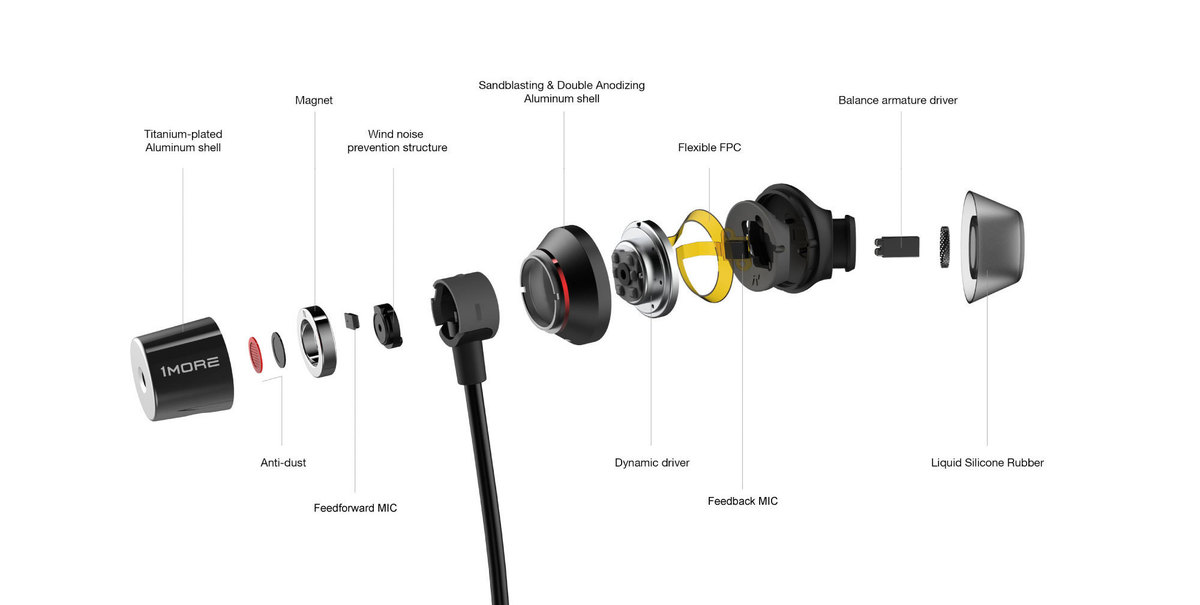 1More
1MoreEach earpiece includes many components, including a dynamic driver, balanced-armature driver, and two microphones.
A separate mic in the neckband picks up your voice during phone calls. The company calls this mic ENC (environmental noise cancelling), which, combined with a DNN (deep neural network) algorithm, is said to filter out ambient noise for clear phone calls, even in loud settings.
The Dual Driver ANC Pro implements Bluetooth 5, which provides faster transmission over longer distances compared with Bluetooth 4.2. It supports Sony’s LDAC codec for Android and AAC (Advanced Audio Coding) for Apple products. Both are lossy but higher quality than most Bluetooth codecs; in particular, LDAC boasts a data rate of 990Kbps compared with 328Kbps for SBC, which is also supported. On the other hand, this IEH does not support aptX.
In addition to Bluetooth, you can connect the Dual Driver ANC Pro to a USB source device, such as a computer, using the USB-C port at the end of the left side of the neckband and listen to lossless audio. Interestingly, the product page includes this caveat: “Headphone must have charge in order to be listened via a wired connection.” Okay, but the same USB-C port is used to charge the battery, so unless the USB source device does not provide power, making this connection will charge the battery, fulfilling that condition by default.
Speaking of the battery, it’s a 160mAh lithium-ion type that’s good for up to 20 hours of music (AAC format, ANC off, 50 percent volume) on a full charge, which takes about one hour to complete from an empty state. Even better, a quick 10-minute charge provides up to three hours of play time. Interestingly, files in the LDAC format gobble battery power much more quickly, lasting only about eight hours at 50 percent volume with ANC off. Turning ANC on cuts three to four hours from the total play time—except for LDAC, which only loses about half an hour.
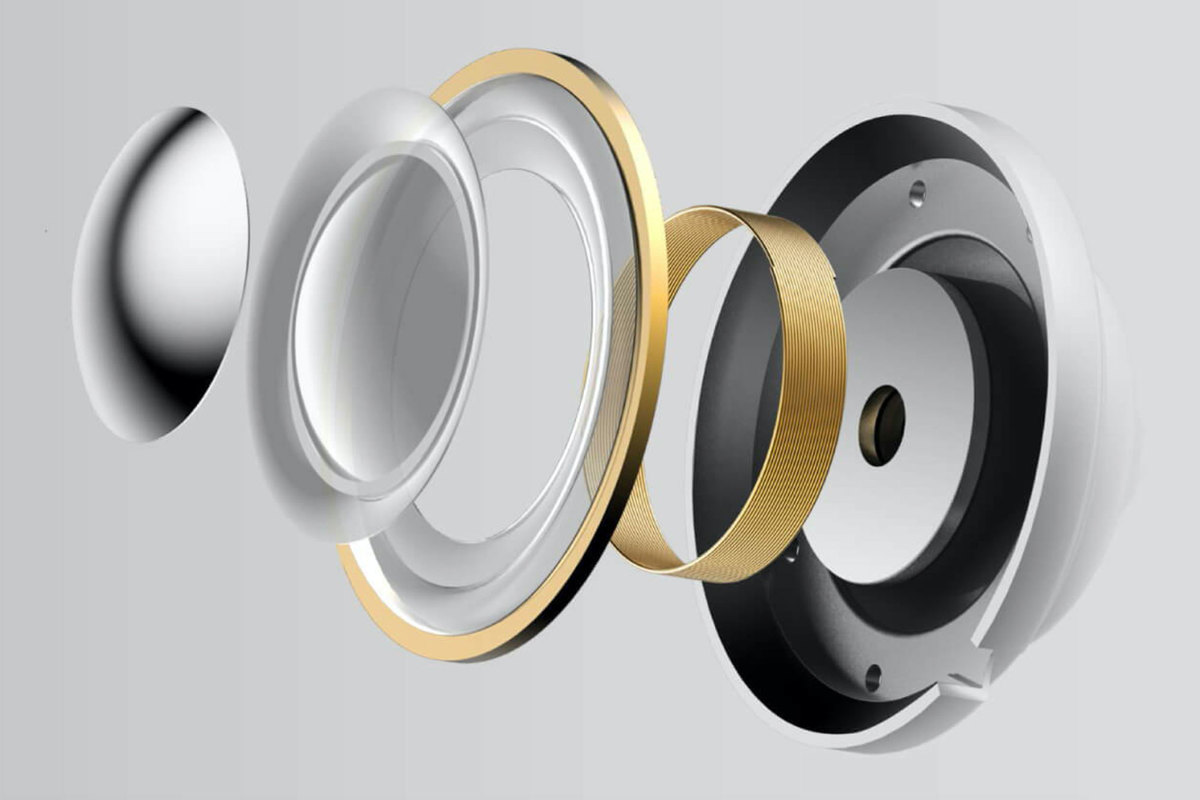 1More
1MoreEach earpiece includes many components, including a dynamic driver, balanced-armature driver, and two microphones.
User Interface
As I mentioned earlier, the controls are located on the neckband—specifically, on the left side. On the top, there are three buttons: power on/off, wind noise reduction on/off, and ANC 1/2/off.
On the inside surface are the volume up and down buttons on either end of a rocker switch as well as the play/pause button, which also skips to the next or previous track by pressing it twice or three times respectively. This button also lets you answer, hang up, and decline a phone call, and you can activate your device’s voice control (such as Siri and Google Assistant) by holding the button, but only when there is no music playing or a phone call in progress.
Changing the power, ANC, and wind noise-reduction settings provides an audible cue that indicates when they are switched on or off and which ANC mode is selected. The cues are short, distinctive sound effects, which is okay, though I would prefer voice prompts stating the current condition and battery level as some headphones, including many 1More models, provide.
The company also offers a free app called 1More Music for iOS and Android devices. The app is simple and straightforward, allowing you to enable or disable ANC and wind noise reduction. It also offers a quick guide to the product and a battery-level indicator.
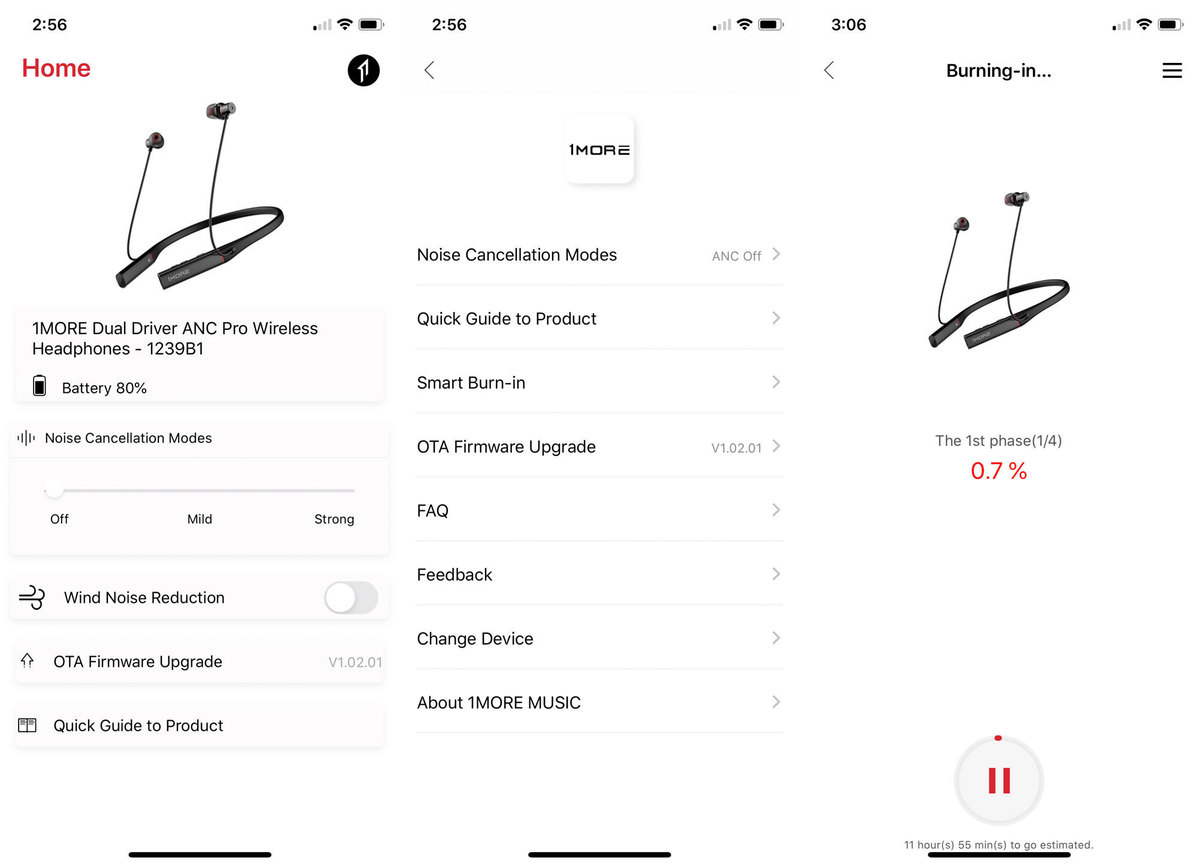 Scott Wilkinson / IDG
Scott Wilkinson / IDGThe 1More Music app provides complete control for the Dual Driver ANC Pro (as well as other 1More models), including ANC modes, wind noise reduction, and firmware updates. Also on the home screen (left) is a battery-level indicator and a link to a quick guide. The secondary screen (center) offers access to some of the same controls as well as additional info and the Smart Burn-In feature, which plays noise signals over a total of 12 hours (right).
Another feature in the app is called Smart Burn-In, which plays noise signals for a total of 12 hours to break in the drivers. I don’t place much stock in the notion that breaking in drivers makes a big difference in sound quality, so I didn’t do it in this case. But it’s there if you feel differently.
In addition, the app reveals the firmware version and lets you update it if necessary. My review sample had version 1.01.05, while the current version is 1.02.01, so I updated it.
Performance
For the best performance from any IEH, it’s critical to select the right eartips for your particular ears. The eartips should completely seal your ear canals; if they’re too small, environmental sounds get through, the overall sound quality is thin and fizzy, and the bass is anemic.
The Dual Driver ANC Pro comes with four pairs of silicone eartips: 11mm, 13mm, 14.2mm (pre-installed), and 15.5mm. All have an oval cross section, which is intended to help them achieve a good seal in the oval opening to the ear canal. The nozzles on which the eartips are installed are also oval, assuring that the tips are in the correct orientation. It’s a tight fit and a bit tricky to change out the eartips. I normally use 1More’s circular 14.5mm silicone eartips on all IEHs, but I tried the 14.2mm tips that come with the Dual Driver ANC Pro, and they worked fine for me.
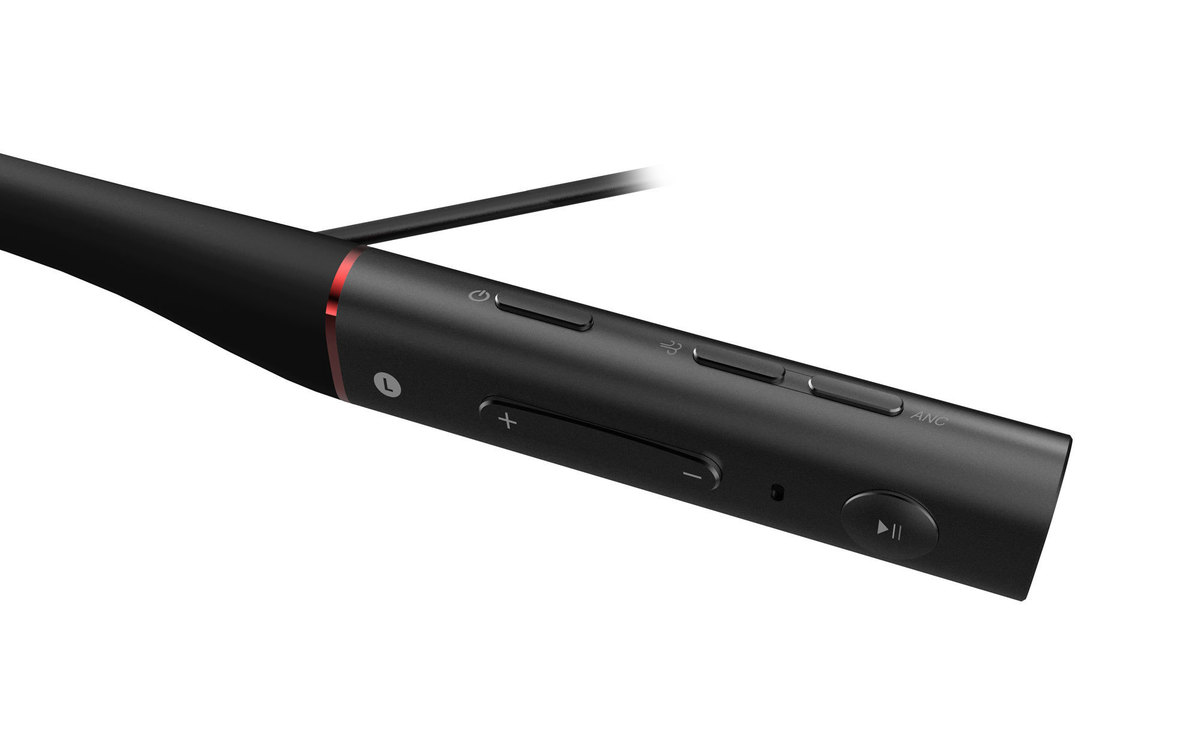 1More
1MoreThe controls on the left neckband include power on/off, wind noise reduction on/off, and ANC 1/2/off on the top and volume up/down and play/pause/answer/hang up phone calls on the side.
As usual, I turned to Tidal’s Master library from my iPhone XS as the source for test tracks. First up was “Flame Twin” from Norah Jones’ new album Pick Me Up Off the Floor. With ANC off, the sound was clean and well balanced with clear and present vocals. Turning ANC on—which starts at the stronger setting—the level increased substantially, and the sound became much richer with elevated bass that was a bit overbalanced. The milder ANC setting sounded about the same.
I had never heard the electronica of Apparat before, but “Hosea” from Soundtraks: Dämonen is a wonderful kaleidoscope of timbres swirling around the stereo soundfield. With ANC off, the sound was clean but a tad thin and anemic. I preferred the richer, deeper sound with ANC on in this case. Again, there wasn’t much difference between ANC Level 1 and 2.
Another new discovery—this time in jazz—was bassist and composer Misha Mullov-Abbado. I listened to “Seven Colours” from his album Dream Circus, which includes piano, acoustic bass, and drums along with trumpet, alto sax, and tenor sax playing some beautifully inventive melodic and harmonic ideas. With ANC off, the sound was clean, lean, and tight; turning it on caused the sound to become much richer and fuller, and the bass was a bit overbalanced and indistinct.
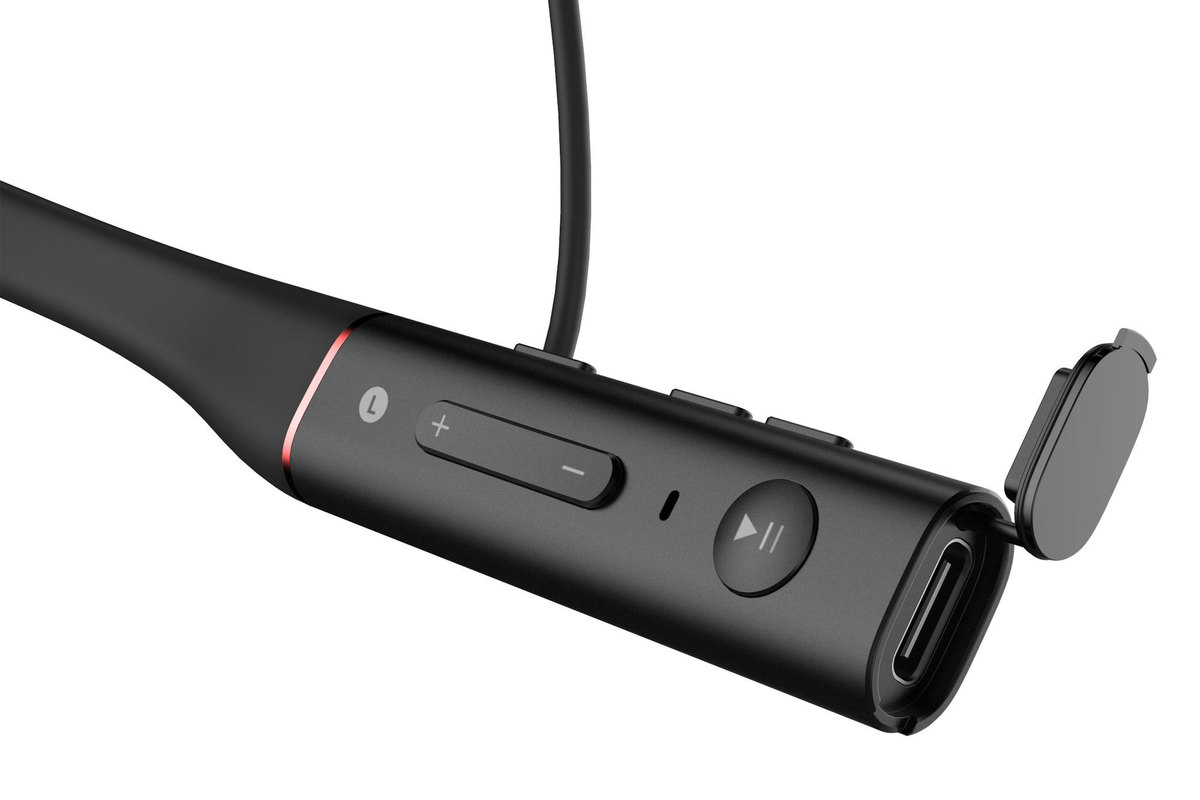 1More
1MoreThe USB-C port at the end of the left neckband connects to a charger, and it can also be connected to a USB port on a computer to play audio without Bluetooth.
Turning to country, I checked out “Maggie” from Sarah Jarosz’ album World on the Ground. She has an exquisite voice, and the recording quality is exceptional. With ANC off, the sound was clean and well-balanced. Turning ANC on, the track became louder and richer with more bass—perhaps a bit too much.
Moving into more familiar territory, I listened to the first movement of Beethoven’s Piano Sonata No. 8, Op. 13 “Pathétique” as performed by Wilhelm Backhaus on the aptly named album Beethoven Sonatas. This time, with ANC off, the piano sounded thin and even a bit strident. Turning ANC on, the track was louder and fuller, which I strongly preferred.
For a few more instruments, I cued up the first movement of Wind Quintet, Op. 79 by August Klughardt as performed by Les Vents Français on their album Romantique. With ANC off, the sound was clean and a bit thin, and each instrument was clearly delineated. Turning ANC on, the track became louder and richer, and I could still make out each instrument quite easily.
For some big guns, I listened to the third movement of John Adams’ Must the Devil Have All the Good Tunes? as performed by the Los Angeles Philharmonic under Gustavo Dudamel with Yuja Wang playing the featured piano part. Once again, with ANC off, the sound was clean and clear with somewhat lean bass and excellent delineation of individual instruments and sections. The track got louder and fuller with ANC on, and the bass became a bit overbalanced.
To test the phone-headset performance, I had my wife call me. It worked better in this respect than any other IEH I’ve tried; her voice sounded warm and clean, and she reported that my voice sounded excellent as well.
Finally, I took the Dual Driver ANC Pro out to the garage and ran the clothes dryer to test its noise cancellation. The stronger Level 1 setting certainly reduced the low-frequency rumble, but it was less effective than other ANC headphones I’ve tried. The milder Level 2 setting let a bit more noise through, but the difference wasn’t pronounced.
 1More
1MoreThe 1More Dual Driver ANC Pro Wireless are among the best-performing smartphone companions we’ve tested.
Comparison to 1More Stylish, Sony WH-1000XM3
The only other true wireless IEH I had on hand during this review was the 1More Stylish, which I reviewed here, so I listened to each track with them as well as the Dual Driver ANC Pro. In every case, the Stylish sounded much like the Dual Driver ANC Pro with its ANC off—clean, clear, and well-balanced most of the time. Overall, the Stylish had slightly less depth, though in some cases, such as “Seven Colours” and “Maggie,” the bass was a bit more present.
My wife and I compared the sound of the Stylish and Dual Driver ANC Pro on a phone call and found that the Stylish sounded much worse—thin and electronic at both ends. By contrast, the new model sounded clear and natural.
During my noise-cancellation test, I compared the Dual Driver ANC Pro with the Sony WH-1000XM3, reviewed here, which is the best ANC headphone I’ve tried. The Sony provided far more noise reduction, which is to be expected with an over-ear headphone. Even with a good seal in the ear canal, it’s extremely difficult for an IEH to block as much sound.
Bottom line
The 1More Dual Driver ANC Pro has a split personality. With ANC off, its sound is clean and lean—even a bit thin on some tracks—but when you turn ANC on, the sound becomes rich and sumptuous with bass that is sometimes overbalanced. Either way, the sound is not bad by any means—no distortion, no congestion, no veiling. I’m going to assume that most people will want to use this IEM with ANC on, so if you’re a basshead, you’ll love it in that mode.
But if you favor a leaner, less bass-heavy balance, you might find it a bit much. In that case, you can turn ANC off, which isn’t all that effective anyway. It does reduce ambient noise somewhat, but not nearly as much as some over-ear headphones I’ve tried. On the plus side, its sound as a phone headset is excellent, and I really like the neckband form factor with its well-spaced controls and attached earpieces that can’t get lost.
Is the 1More Dual Driver ANC Pro Wireless worth $150? If you don’t care about ANC, the answer is yes—you can turn ANC off for a leaner sound or on for a richer, bass-heavy sound according to your preference. On the other hand, if you want ANC with a clean and lean sound or no ANC with lots of bass, then no. It’s entirely up to you.

Introvert. Beer guru. Communicator. Travel fanatic. Web advocate. Certified alcohol geek. Tv buff. Subtly charming internet aficionado.